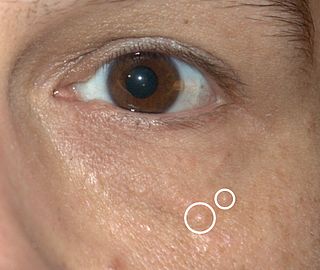
A xanthoma, from Greek, Modern ξανθός (xanthós), meaning 'yellow', is a deposition of yellowish cholesterol-rich material that can appear anywhere in the body in various disease states. They are cutaneous manifestations of lipidosis in which lipids accumulate in large foam cells within the skin. They are associated with hyperlipidemias, both primary and secondary types.
Hypertriglyceridemia denotes high (hyper-) blood levels (-emia) of triglycerides, the most abundant fatty molecule in most organisms. Elevated levels of triglycerides are associated with atherosclerosis, even in the absence of hypercholesterolemia, and predispose to cardiovascular disease. Very high triglyceride levels also increase the risk of acute pancreatitis. Hypertriglyceridemia itself is usually symptomless, although high levels may be associated with skin lesions known as xanthomas.

Xanthelasma is a sharply demarcated yellowish deposit of cholesterol underneath the skin. It usually occurs on or around the eyelids. While they are neither harmful to the skin nor painful, these minor growths may be disfiguring and can be removed. There is no high-quality evidence that xanthelasma deposits are related to blood low-density lipoprotein levels or increased risk of atherosclerosis.
Hyperlipidemia is abnormally elevated levels of any or all lipids or lipoproteins in the blood. It is the most common form of dyslipidemia.
Diabetic dermopathy is a type of skin lesion usually seen in people with diabetes mellitus. It is characterized by dull-red papules that progress to well-circumscribed, small, round, atrophic hyperpigmented skin lesions usually on the shins. It is the most common of several diabetic skin conditions, being found in up to 30% of diabetics. Similar lesions can occasionally be found in non-diabetics usually following trauma or injury to the area; however, more than 4 lesions strongly suggests diabetes.

Syringomas are harmless eccrine sweat duct tumors, typically found clustered on eyelids, although they may also be found in the armpits, abdomen, chest, neck, scalp or groin area including genitals in a symmetric pattern. They are skin-colored or yellowish firm, rounded bumps, 1–3 mm in diameter, and may be confused with xanthoma, milia, hidrocystoma, trichoepithelioma, and xanthelasma. They are more common in women and are most commonly found in middle-aged Asian women. While they can present at any time in life, they typically present during adolescence. They are usually not associated with any other symptoms although can sometimes cause itchiness or irritation.

Sitosterolemia is a rare autosomal recessively inherited lipid metabolic disorder. It is characterized by hyperabsorption and decreased biliary excretion of dietary sterols. Healthy persons absorb only about 5% of dietary plant sterols, but sitosterolemia patients absorb 15% to 60% of ingested sitosterol without excreting much into the bile. The phytosterol campesterol is more readily absorbed than sitosterol.
Oskar Simon was a German dermatologist who was a native of Berlin.
Verruciform xanthoma is an uncommon benign lesion that has a verruciform (wart-like) appearance, but it may appear polypoid, papillomatous, or sessile. The verruciform was first described by Shafer in 1971 on the oral mucosa. Usually found on the oral mucosa of middle-aged persons, verruciform xanthomas have also been reported on the scrotum and penis of middle-aged to elderly Japanese males. While the most common site is the oral mucosa, lesions that occur elsewhere usually arise on the perineum or on the skin with some predisposing factor, such as lymphedema or an epidermal nevus.
Non-X histiocytoses are a clinically well-defined group of cutaneous syndromes characterized by infiltrates of monocytes/macrophages, as opposed to X-type histiocytoses in which the infiltrates contain Langerhans cells. Conditions included in this group are:
Xanthoma disseminatum is a rare cutaneous condition that preferentially affects males in childhood, characterized by the insidious onset of small, yellow-red to brown papules and nodules that are discrete and disseminated.
Papular xanthoma is a cutaneous condition that is a rare form of non-X histiocytosis.

Familial dysbetalipoproteinemia or type III hyperlipoproteinemia is a condition characterized by increased total cholesterol and triglyceride levels, and decreased HDL levels.
Xanthomatous biliary cirrhosis, is a condition in which there is hyperlipoproteinemia due to liver disease resulting in plane xanthomas.
Medication-induced hyperlipoproteinemia is a condition that results from the decreasing of lipoprotein lipase activity resulting in eruptive xanthomas.
Normolipoproteinemic xanthomatosis is a cutaneous condition characterized by a xanthoma in the presence of normal cholesterol and lipoprotein levels.
Xanthoma striatum palmare is a cutaneous condition characterized by xanthomas of the palmar creases which are almost diagnostic for dysbetalipoproteinemia.





